Wed 11 Dec 2013
A Movie Review by David Vineyard: THE GOLDEN SALAMANDER (1950).
Posted by Steve under Action Adventure movies , Reviews[9] Comments
THE GOLDEN SALAMANDER. General Film Distributors, UK, 1950; Eagle-Lion Classics, US, 1951. Trevor Howard, Anouk (Aimée), Herbert Lom, Wilfrid Hyde-White, Walter Rilla, Miles Mallenson, Jacques Sernas, Peter Copely Screenplay: Ronald Neame, Leslie Storm & Victor Canning, based on the latter’s novel. Cinematography: Oswald Morris. Director: Ronald Neame.
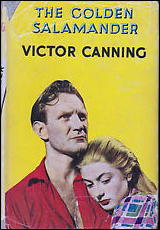
“We are given eyes, but not without the wisdom to keep them shut.†: Aribe (Peter Copely) to archaeologist David Redfern (Trevor Howard).
David Redfern is a British archaeologist sent to Tunis to recover Etruscan art treasures washed ashore years earlier in a storm, and now in the cellar of Serafis (Walter Rilla), a wealthy man who lives in the villa Ben Negro in the small village of Kabarta on the coast. For Redfern it promises to be a nice trip, an interesting job of cataloging and repacking the treasures, and a few weeks of sun and fishing in between.
His arrival is none to promising though, in a driving rain storm and on a narrow rocky road, he runs into a rock-fall blocking the road. Nothing for it but to foot it to Kabarta in the driving rain and the cafe/inn where he has a reservation. But on the other side of the rock-fall he spies a wrecked lorry — and carrying a cargo of Browning automatic pistols. Gun runners.
When he hears another lorry coming Redfern decides not to get involved and watches from a grove of cork trees near the road. Two men get out of the lorry, Herbert Lom, and Jacques Sernas. Redfern decides to stay out of it though. A little gun running is none of his business. He hikes to the cafe where he meets piano player Agno (Wilfrid Hyde-White) and the beautiful French expatriate owner, Anne Tabu (Anouk) to whom he is immediately attracted. It promises to be a good trip after all.
The next day he meets Serafis (Walter Rilla), a charming type happy to be rid of the treasures he has been guarding, and Douvet (Miles Mallinson) the local police chief. He has almost forgotten the lorry and the guns until the two men come in the cafe — one Rankl (Lom) and the other Max (Sernas), Anne’s brother.
There were many fine writers of adventure and suspense in the late forties and well into the eighties, names like Hammond Innes, later Gavin Lyall, Alan Williams, Alistair Maclean, but there was always something more to Canning, a weight, almost a gravity, to his grounded professional heroes, reluctant perhaps, but capable and when needed ruthless.
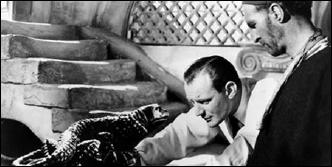
Though Canning’s novels became darker, especially about the security services, his capable and professional heroes only grew deeper. Even the hapless vicar in The Great Adventure turns out to be adept at crime and skullduggery. Eric Ambler and Graham Greene’s trapped and often foolish heroes weren’t for him. A Canning hero is always a professional man, engineer, archaeologist, reporter, ships captain, private detective, spy …
And perhaps because Canning began as a novelist rather than a thriller writer his books had something more, an indefinable quality that you could distinguish in only a few pages. His books were vivid and cinematic, but never at the expense of character or style.
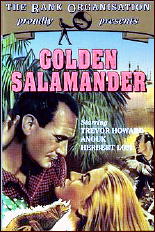
David Redfern is a typical Canning hero, and facing a typical Canning dilemma: are we responsible to confront evil, or only spectators who should, as Aribe the Arab worker suggests, keep our eyes shut. Among the Etruscan artifacts is a golden salamander and on it engraved: “Not by ignoring evil does one overcome it, but by going to meet it.†The two sides of the coin, alpha omega, become part of the evil by denying it exists, or confront it and risk the consequences.
Falling for Anne and admiring her brother’s art and devotion to his sister is the difference for Redfern, the weight on the scale, he offers Max a way out — passage to France, and work as an artist, and Max accepts.
Small actions have big repercussions. A few days later David and Anna spend a day fishing and swim at the beach — where they find Max’s weighted body, murdered by Rankl.
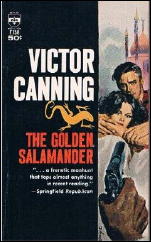
Guilty and angry David decides to go to the authorities, but Douvet is a pawn of the conspiracy, the phone lines are down to Tunis, and even the mail is controlled By Douvet’s mistress. Finally he goes to Sernas for help, only to find Sernas is the leader of the criminals and plans for David to have an ‘accident’ at the towns big yearly boar hunt the next day. With only Anne on his side he’s hopeless. Even Agno is part of it.
But Agno has weakness other than absinthe — he loves Anna and Max.
Location shooting, Neame’s sure hand directing suspense films (David Lean was once his editor), the cinematography by Oswald Morris, camera work by cinematographer and director Freddie Francis, and a fine cast combine for a truly enjoyable adventure, slow to build, but with a fine chase at the end. This is the traditional adventure film, not an endless concussive assault of constant action, but actual characters with inner lives and difficult choices to make.
Lom is at his slimy best, and manages to even slip a hint of an unhealthy obsession about Max into his meaningful glances, Rilla, always a smooth villain in the Claude Rains mode brings a fine sinister streak to Serafis bluffing a playing up to the last moment, and Hyde-White, different than you usually see him as Agno, the absinthe addicted piano player who observes even participates in conspiracy, but will only go so far, gives a fine little performance looking quite different than you likely picture him.
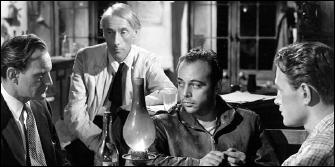
Anouk is a revelation here. Wearing little makeup and playing as a sensual innocent she has something of the freshness and promise of a young Ingrid Bergman. You can see why Redfern falls in love with her innocent rather melancholy Anne, and why a man would confront dragons for her — or even salamanders. She is well matched with Howard whose presence as a leading man was as assured as his later character roles.
Howard did several films in this vein in this period, Malaga (with Dorothy Dandridge), They Made Me a Criminal, the Archers The Adventuress, and the legendary The Clouded Yellow. Neame’s experience in this genre dates back to the fine thriller Take My Life based on Winston Graham’s novel in the thirties and he was adept in other genres as well. It was a natural collaboration.
This solid entertaining thriller isn’t all that well known, but deserves better. You can watch it online at several movie sites (most requiring a paid subscription), and the print is a good clean one. Catch it and see how effortless they used to make it look. This is a fine example of the British thriller at its near best, and a fine adaptation of one of Victor Canning’s best.
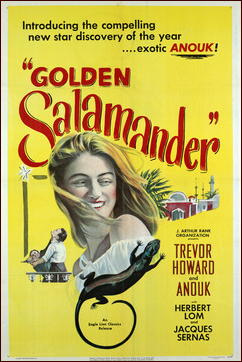
December 11th, 2013 at 3:23 pm
Enticing review! Always wanted to read this one. I have it on a list of titles available at the CPL and *still* haven’t taken out the book. So many books… Now I have the movie added to my list of “Must Watch Flicks”
December 11th, 2013 at 7:57 pm
I never thought Canning received the attention he deserved here (he was better appreciated at home) though many of his early books had paperback publication, and many, though not all, of his later books.
I considered Canning the equal of Hammond Innes, he was a better writer than Alistair MacLean, and marginally superior to Gavin Lyall in literary terms. Quite a few books were made into films as well including this, The House of Seven Hawks (The House of Turkish Flies in print), The Limbo Line, The Scorpio Letters, Hitchcock’s Family Plot (The Rainbird Pattern), Sam Fuller’s Shark!, Masquerade (Castle Minerva), Spy Hunt (Panther’s Moon)…
He wrote some fine humorous novels at the beginning, later penned some bestselling Arthurian novels, and never faltered at his thrillers.
Like Innes and Lyall, Canning has no equivalent now, no one does this with his literacy, his seriousness, or his sometimes dark humor. This one was a very good film adaptation of a very good book, keeping the then (and always) serious theme of the book, a not too subtle warning about ignoring evil as so many had only a decade before.
Forgot to mention in the review it was filmed in Tunisia on location, and it shows, though there are some obvious studio sets as well.
In England Canning even made it into comics, his Oasis Nine and others adapted in the British picture digests that were popular there.
December 12th, 2013 at 3:58 am
Nice job, David! I saw the movie a few years back and as I recall, Wilfrid Hyde-White has the same role here that Hoagy Carmichael played in TO HAVE & HAVE NOT. Looks a bit like him, too. And come to think of it he had an equally small and effective part in another Trevor Howard flick: OUTCAST OF THE ISLANDS.
December 12th, 2013 at 4:02 am
I like the BIRDCAGE series which Canning wrote in his later years.
December 12th, 2013 at 2:36 pm
Speaking of Gavin Lyall, I once wrote an essay about him for a reference book and think I corresponded with him. Friends in town had met him and his wife, Katherine Whitehorn, when they were in England and invited them to stay with them when they were in Northfield, MN. Knowing my interest in his thrillers they invited me over to have dinner with them and to meet Gavin. I showed up with a briefcase of copies of his books that he graciously signed. Somewhere in my personal archives I have a photograph of the two of us together.
December 12th, 2013 at 2:50 pm
Randy
Lucky man. Lyall was one of my favorites, and MIDNIGHT PLUS ONE on my short list of the best thrillers in the genre.
Josef
Agree about the BIRDCAGE series, By then Canning’s view of the security services had soured, and the books were darker, though going back you can see hints of darker things behind the adventures.
December 12th, 2013 at 6:05 pm
David,
I really like MIDNIGHT PLUS ONE too. When Gavin Lyall died I scrambled to get copies of his later books that I had missed getting when they first appeared. One or two were either very expensive or hard to find. I remember placing an order with one bookstore and then calling them about it. The dealer said she was just wrapping a copy of the book, but it turned out to be addressed to someone else!
December 13th, 2013 at 5:11 pm
Dan
I forgot about OUTCAST, you’re right, and I recall the first thing I thought when I saw him in Salamander was Carmichael’s Cricket in TO HAVE AND TO HAVE NOT. I half expected Anouk to walk by and do that little hoochie dance Bacall offers at the end of THATHN.
It’s a very different view of Hyde-White though, makes me wonder what his Philo Vance was like in THE SCARAB MURDER CASE.
Randy,
Ouch!
I was lucky, there was a paperback available of Lyall’s early THE MOST DANGEROUS GAME, and SHOOTING SCRIPT and WYATT’S HURRICANE were both available at the same time MIDNIGHT hit paperback.
I’ve driven one of those hydraulic Citroen salons from the novel — Lyall’s research — as always — was impeccable. Of course he could carry it too far — he almost abandoned VENUS WITH GUN because he couldn’t recreate one of the things he has the rare pistol do. Took him twice as long as he planned to write it tinkering with that experiment.
December 13th, 2013 at 9:08 pm
Obviously WYATT’S HURRICANE is Desmond Bagley. I was thinking of THE WRONG SIDE OF THE SKY, and SHOOTING SCRIPT came out a year after MIDNIGHT.